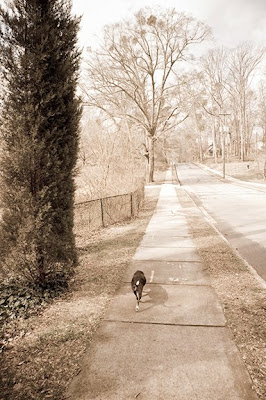
Lightroom gets me started
I photograph my dog a lot, and since at 13 years old, she is still draggin me around the neighborhood, there's a perspective tendency. More than you needed to know? ahem.
But when using the D700 (back on msg) in duotone mode, I made an exposure that was way hot, but liked it so much I used it as a creative starting point in my conversion through Lightroom. I was talking with my friend
Beth Lilly the other day about how the LCD on a digital SLR is a collaborative partner that we didn't have previously. Even though I convert everything from raw files, I still strive for a good in camera WB.
Years ago I worked briefly with
Joel Meyerowitz. At the time of every exposure, he made a written list of verbal descriptions that would then serve as a printing guide. Joel was exposing VPL, a tungsten balanced film in all sorts of daylight conditions, so a standard color pack derived from a Kodak test negative (a
Shirley) was pretty much worthless. The verbal descriptor was used to
torture inform his printers regarding the palette and tone desired from those negs. Big fun. Now we have a jpg. Better fun.
The conversation I had with my friend Beth, was in the context of our immediate creative attraction and response to a scene. That response could either encourage (or not) further exploration within any particular moment or setting. Beth does
very interesting work with a cell phone and the feedback from the device is an essential part of the process. If it looks promising, continue to work the scene. If not, move on.
Things look different in a photograph and on the LCD than they do when you perceive them directly, and that syntactical appearance can influence the final rendering of an image, even (or especially) as you are engaged in the process of making the photograph.
This is why, even though I may ultimately create the duotoned image from the full spectrum raw file, I use the camera display to create a sort of collaborative feedback that leads me toward such ultimate decisions as contrast, tonal abbreviation, white balance and saturation. And of course, composition (like the ground glass of a field camera). It also gets me back to that in the moment mindset when I am formulating my interpretation at the desktop.
This "touchstone" concept works in color, too and is why I always strive to hit a WB in camera that I feel compliments the subject/moment and my desired effect or mood, and will enhance the capture processes as well as the post-production creative processes. It melds my visual thinking to my intuitive and visceral responses.
One situation I have found this quite important in, is when a portrait subject can either be enthralled or horrified by the image on the screen. Use with discretion.
At the top of this post is an image that I created out of my immediate response to that overexposed, warm toned display on my LCD, while walking with Bailey.
I started with the Creative Aged preset in Lightroom, and altered almost everything. The adjustment brush with minus "Exposure" let me bring the sky back in. Some saturation came back, tonal shifts and Clarity and other stuff, too... t









